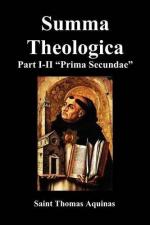over against the door of the tabernacle seven times”;
for the number seven signified universality.
Further, the very sprinkling of blood pertained to
the detestation of idolatry, in which the blood that
was offered up was not poured out, but was collected
together, and men gathered round it to eat in honor
of the idols. Likewise it was burnt by fire, either
because God appeared to Moses in a fire, and the Law
was given from the midst of fire; or to denote that
idolatry, together with all that was connected therewith,
was to be extirpated altogether; just as the cow was
burnt “with her skin and her flesh, her blood
and dung being delivered to the flames.”
To this burning were added “cedar-wood, and
hyssop, and scarlet twice dyed,” to signify that
just as cedar-wood is not liable to putrefaction,
and scarlet twice dyed does not easily lose its color,
and hyssop retains its odor after it has been dried;
so also was this sacrifice for the preservation of
the whole people, and for their good behavior and
devotion. Hence it is said of the ashes of the
cow: “That they may be reserved for the
multitude of the children of Israel.” Or,
according to Josephus (Antiq. iii, 8, 9, 10), the
four elements are indicated here: for “cedar-wood”
was added to the fire, to signify the earth, on account
of its earthiness; “hyssop,” to signify
the air, on account of its smell; “scarlet twice
dyed,” to signify water, for the same reason
as purple, on account of the dyes which are taken
out of the water: thus denoting the fact that
this sacrifice was offered to the Creator of the four
elements. And since this sacrifice was offered
for the sin of idolatry, both “he that burned
her,” and “he that gathered up the ashes,”
and “he that sprinkled the water” in which
the ashes were placed, were deemed unclean in detestation
of that sin, in order to show that whatever was in
any way connected with idolatry should be cast aside
as being unclean. From this uncleanness they
were purified by the mere washing of their clothes;
nor did they need to be sprinkled with the water on
account of this kind of uncleanness, because otherwise
the process would have been unending, since he that
sprinkled the water became unclean, so that if he
were to sprinkle himself he would remain unclean;
and if another were to sprinkle him, that one would
have become unclean, and in like manner, whoever might
sprinkle him, and so on indefinitely.
The figurative reason of this sacrifice was that the
red cow signified Christ in respect of his assumed
weakness, denoted by the female sex; while the color
of the cow designated the blood of His Passion.
And the “red cow was of full age,” because
all Christ’s works are perfect, “in which
there” was “no blemish”; “and
which” had “not carried the yoke,”
because Christ was innocent, nor did He carry the
yoke of sin. It was commanded to be taken to Moses,
because they blamed Him for transgressing the law
of Moses by breaking the Sabbath. And it was
commanded to be delivered “to Eleazar the priest,”
because Christ was delivered into the hands of the
priests to be slain. It was immolated “without
the camp,” because Christ “suffered outside
the gate” (Heb. 13:12). And the priest dipped
“his finger in her blood,” because the
mystery of Christ’s Passion should be considered
and imitated.




